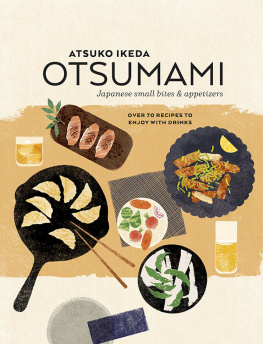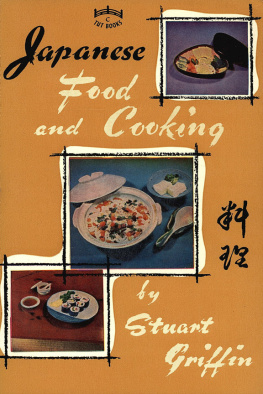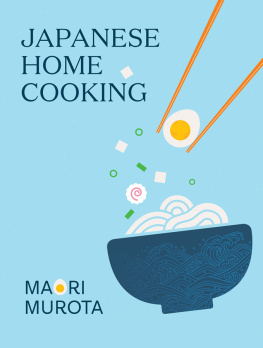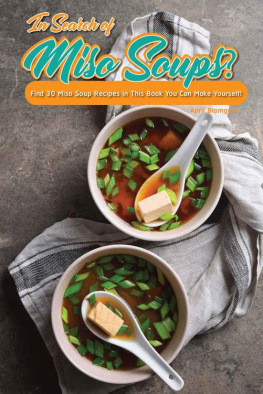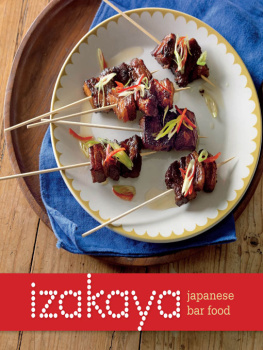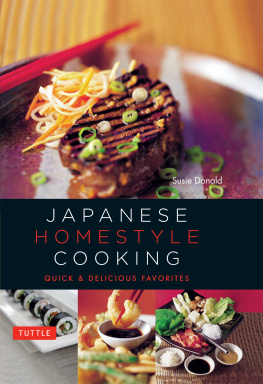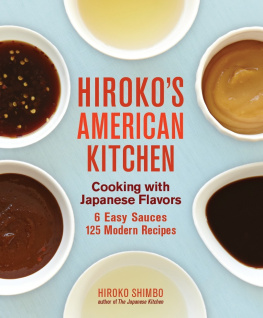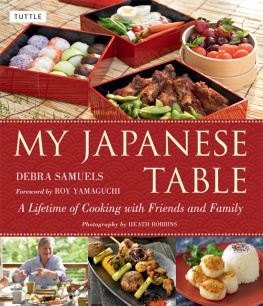
To Yukiyo, who taught me these flavours.
To my parents, who taught me to cook.
To my sisters, without whose encouragement, eating and enlightenment this would have remained scribbles in a notebook.

Contents

Ive had a love story with Japan since my late teens and, athough I currently live in Stockholm, Sweden, Ive tried to introduce ways of continuing to explore the edible treasures of the country, even when Im not there. One such exploration is the local Japanese brunch experience Leaves & Grains I started a few years back. Another is this book, because apart from funnelling my creativity into the kitchen it allows me to indulge in my passions for photography and writing. So this is a compilation of all three elements: a profound fascination with Japanese food and culture as well as a fondness for standing in the kitchen and behind a camera. I have compiled all this into twelve chapters, each looking at a different element on my table.
The following pages are mainly about eating based on the ichijuu-sansai meal tradition small plates for Japanese meals and having tea in the morning and then, of course, some of my memories of Japan.


This book began taking shape about ten years ago, when I had just come back from living in Japan for a year. I didnt go for any particular reason, but somehow just ended up there. Ever since, Ive been strangely attracted to that weird but wonderful place and what its beautiful culture has to offer. Back then I didnt know that I would write this book, but thats when I first began trying out dishes, tentatively recreating those flavours that I increasingly began to miss. I started serving Japanese dishes to my occasionally mesmerised, sometimes reluctant, but mainly excited family, scribbling down combinations of ingredients in a notebook.
The following pages present a collection of the dishes I miss the most when Im not in Japan the food I would have for breakfast or dinner at home. It is not the style you might be served at a Japanese restaurant in Stockholm, London or New York. Simply put, it is my interpretation of the Japanese home-cooked meal or ichijuu-sansai.
When I was living in Osaka (or rather the very small city Kaizuka south thereof), my host mother, Yukiyo, would get up early every morning to prepare a rich miso soup, a small salad and grilled fish or an omelette for breakfast along with rice, of course. Coming from a home where breakfast is sacred, I treasured these moments before running to Nishikinohama station to catch the train to school. It was Yukiyo who started teaching me to cook Japanese food in the first place. Everything she touches is as nourishing as it is flavoursome, so I watched her constantly, tasting carefully. And she was happy to answer my endless questions about ingredient measurements and weird vegetables.
Ive thought long and hard about why the Japanese approach to food appeals to me. I grew up in a home where the vegetable was at the centre of the table and meat was a side dish; to use my mothers words: bacon is a spice. It was also a home where fish was prominent and cream and butter were very, very rare. This meant that Japan and I were initially off to a good start.
Over the years, I have fallen more deeply in love with the way traditional Japanese cooking treats the ingredient like royalty both in appearance and flavour. Spinach should taste like spinach at its finest. Sashimi is served with just soy sauce and wasabi for a reason so that you can truly savour the flavour of the fish. These clean and simple flavours are still what makes me want to eat it every day.


In Japanese, ichijuu-sansai literally means one soup, three dishes. Its a meal with its roots in Zen Buddhism, which has been the foundation of Japanese food culture since the Heian era in the 12th century. It is still what is served for breakfast or dinner in many Japanese homes and what I have chosen to use as a basis for this book.
The centrepiece of ichijuu-sansai is the essential steamed rice. This is accompanied by three side dishes (okazu) and one soup, as well as pickles tsukemono, as theyre called in Japan. On most occasions, the side dishes include one main protein dish, such as grilled fish or tofu, and two smaller ones built around seasonal vegetables. The variations and combinations among side dishes are endless, ensuring that the meal satisfies all the senses and is a wonderful way of achieving diversity in your nourishment. Maybe thats where the beauty lies: in that the ichijuu-sansai gives you both variety and balance between different elements and flavours by preparing and presenting them in simple yet beautiful ways.
Recently, the ichijuu-issai, one soup, one dish, has been gaining popularity in Japan, since its a simpler version requiring less time and preparation. Instead of abandoning the tradition altogether, people are just taking it down a notch. So if you feel intimidated, just start out small.
You can combine the dishes in this book as you like. Depending on mood and time, I go for just one side dish with rice and a soup, or full on with one protein-based main and two sides to go with it. Even just a rich soup with rice and pickles will do the trick. Towards the end of the book, youll find some of my favourite combinations.
The intention behind this book is not to account for a range of traditional Japanese dishes and their exact make-up. The dishes I have chosen are simply flavours Ive stumbled upon or grown to love, and have created and recreated. It is food that I regularly make in my own kitchen, with roots in Japanese homecooking and their way of building a meal. The dishes are all uncomplicated, both in flavour and in preparation, letting each ingredient speak for itself.
Many of these side dishes can be prepared and put in the refrigerator until you are ready to serve, then you just need to heat up some soup, boil the rice and choose which dish to put on which plate. It takes no longer than making a proper avocado sandwich or preparing a bowl of pasta.
As much as I wanted to share what I love in terms of the flavours of Japanese food, this book is also an invitation to cook Japanese dishes without making it complicated. Simplicity is the keyword here. I hope that these are recipes that you dare to try out on any ordinary Tuesday or Friday. For this reason, you wont find very complex and lengthy guides to making the perfect fish stock for miso soup, or pickles that need to be stored for months before eating. I use shop-bought stock base for my miso soup and am far too impatient to wait more than a day or two for my pickles.



